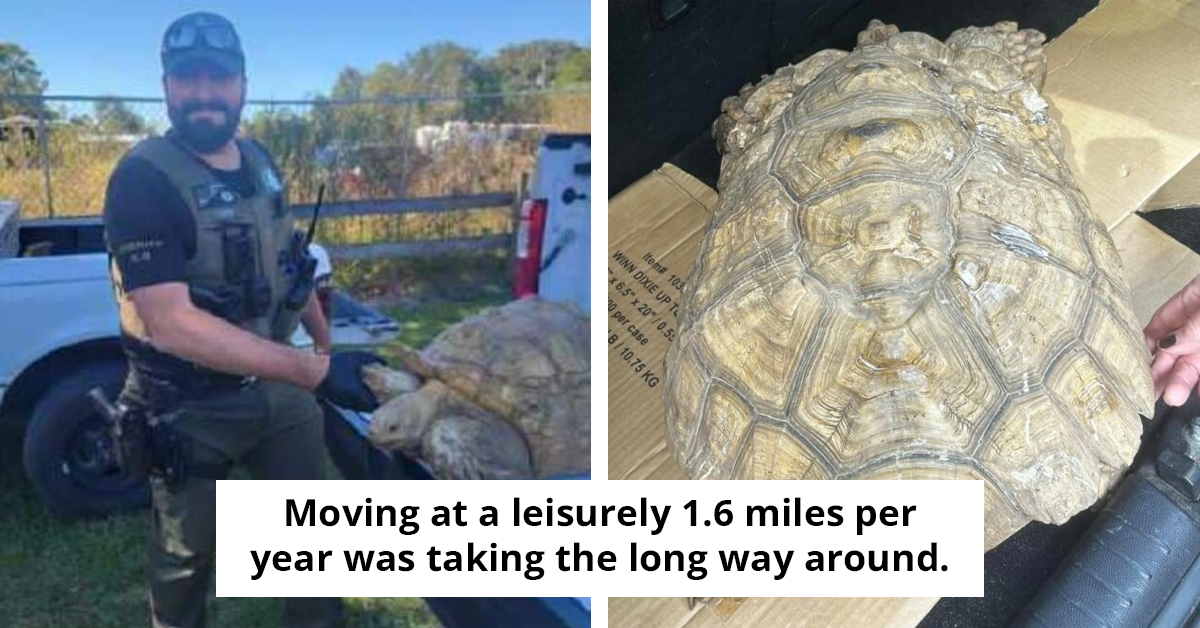Woman And Her Cat Stay At Sister's House, She Is Forced To 'Steal' The Cat Back As Niece Claims It As Her Own
When OP (26F) moved in with her sister and her family temporarily while transitioning between finishing law school, taking the bar, and moving for a new job, she never expected a rift to form over her beloved cat, Toby. A friendly and affectionate feline, Toby had been part of OP's life for seven years.
During OP's stay with her sister's family, her niece (6F) formed a strong attachment to Toby. The little girl loved the cat so much that she began to think of him as her own.
The situation took a turn for the worse one evening at dinner when OP mentioned to her sister that they might consider adopting a cat once she moved out, taking Toby with her. Her sister's unexpected response was, "What do you mean? We have Toby!"
The misunderstanding escalated quickly, leading to a tearful outburst from the niece and growing tensions within the family. Despite OP's offer to help her sister's family adopt a new cat, the pressure mounted, with her sister, brother-in-law, and even her mother insisting that she leave Toby behind and find a new pet for herself.
OP found herself torn between her family's wishes and her loyalty to Toby, whom she considers part of her family. The dilemma led to a divide within the family, with some accusing OP of being childish and others supporting her decision to keep her cat.
OP asks:

OP moved in with her sister temporarily

The issue: her niece fell in love with the cat
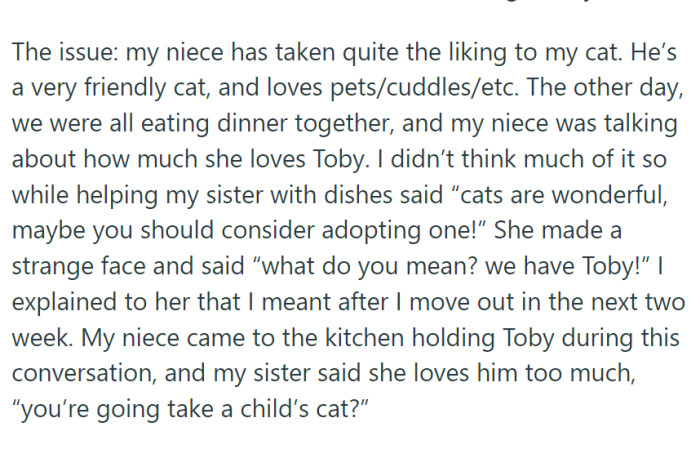
Attachment theory, developed by John Bowlby, emphasizes the bond between individuals and their pets. Research indicates that pets can serve as secure attachments, providing emotional support and comfort.
During transitions, like moving in with family, attachment to a pet can alleviate stress and contribute positively to well-being. A study published in the Journal of Personality and Social Psychology found that pet ownership is associated with lower levels of anxiety and depression, particularly during significant life changes. This may explain OP's strong attachment to Toby.
Strategies for Emotional Regulation
When faced with emotional turmoil, practicing mindfulness can enhance emotional regulation. Research from the University of California, Berkeley, shows that mindfulness techniques can help individuals process their feelings more effectively.
For OP, engaging in mindfulness exercises could provide clarity and emotional balance as she navigates her attachment to Toby and the rift with her niece. Techniques such as deep breathing or journaling could help her articulate her feelings and develop a plan for addressing the conflict in a constructive manner.
Attachment and Ownership
Dr. Laura Green, a developmental psychologist at Stanford University, explains that attachment styles can significantly influence how individuals perceive ownership and relationships with pets.
In this case, the niece's claim over the cat reflects a sense of attachment that may challenge the established bond between the woman and her pet.
This was a strange situation - they really believed Toby was theirs
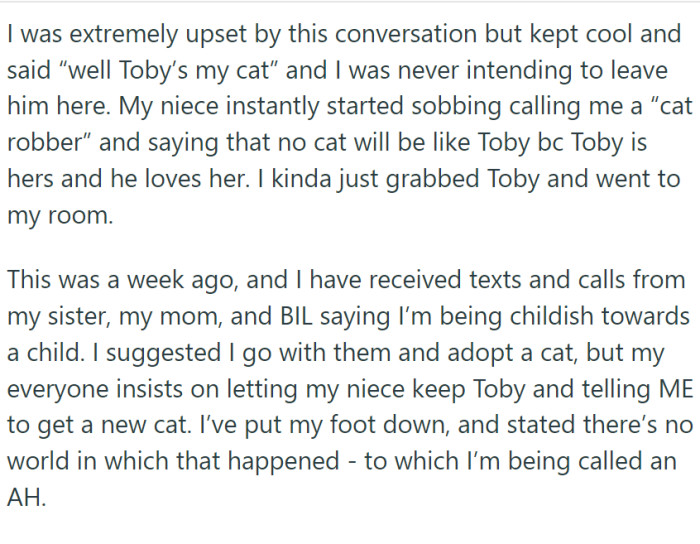
This whole situation is weird and OP has been losing sleep over it

OP has offered the following explanation for why they think they might be the a-hole:

Child Development and Attachment
Children often form attachments to animals, which can support their emotional development. Psychologists suggest that these bonds can foster empathy, compassion, and social skills.
Research from the University of Exeter demonstrates that children who interact with pets tend to show greater social competence and emotional understanding. In this case, the niece’s attachment to Toby reflects her developing emotional skills, but it also poses a challenge for OP as she navigates her role as a caregiver and a pet owner.
Research from the Journal of Applied Psychology indicates that feelings of ownership can evoke strong emotional responses, often leading to conflicts when perceptions of attachment differ.
These conflicts can be particularly challenging due to the emotional investments involved.
This is an interesting suggestion:
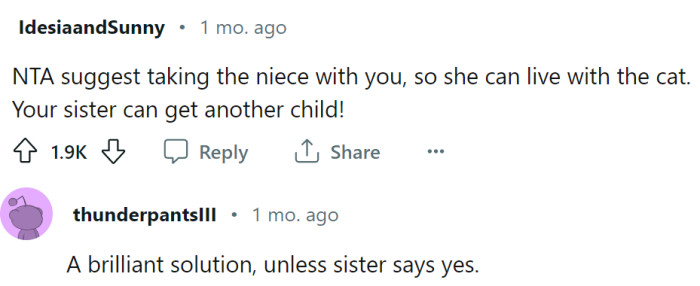
OP should microchip the cat

"How do 2 months with a cat entitle you to someone’s 7-year-old cat?"

Conflict over possession of pets can evoke strong emotional responses. Studies show that ownership disputes often trigger feelings of betrayal, loss, and anxiety.
According to research published in the Journal of Family Psychology, these feelings can lead to significant interpersonal tension. To manage this situation, open dialogue between OP and her sister is crucial. They can benefit from discussing boundaries regarding Toby and acknowledging each other's emotional attachments to foster understanding and resolve the conflict amicably.
Understanding Emotional Bonds
The emotional bond between humans and pets is profound, often mirroring familial attachments.
Studies show that these bonds can lead to complex dynamics regarding ownership and responsibility, especially in shared living situations.
"Children need to be taught boundaries"
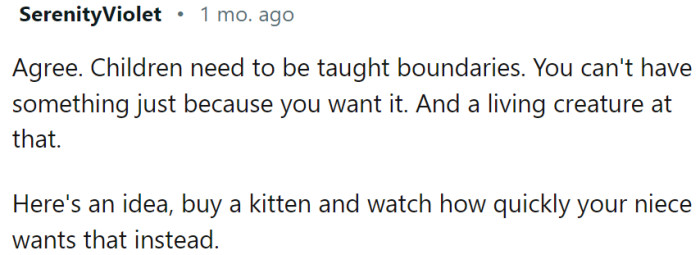
Keeping, not stealing

"Cats are like family, and Toby is yours."
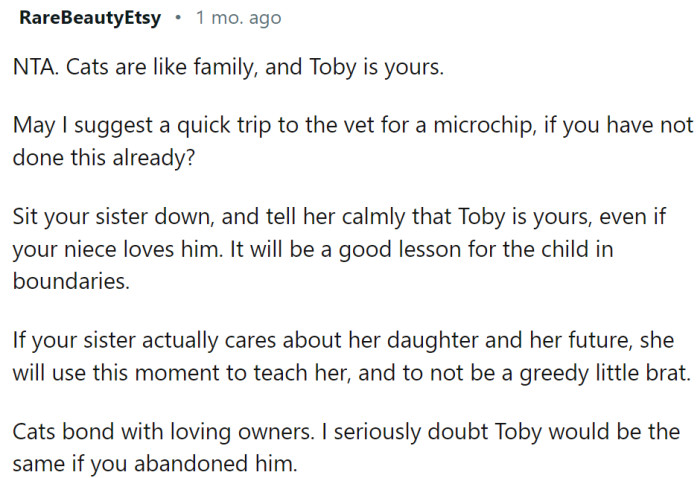
Coping Strategies for Conflict Resolution
Effective conflict resolution involves active listening and empathy. Research from the Harvard Negotiation Project suggests that acknowledging each party's feelings can defuse tension.
In OP's situation, expressing her attachment to Toby while validating her niece's feelings could lead to a mutually satisfying outcome. This approach not only preserves family harmony but also models healthy communication skills for the young girl. It’s essential for OP to navigate this with care, fostering a supportive environment for both her niece and herself.
To navigate these challenges, establishing clear communication regarding pet ownership and responsibilities is crucial.
Research suggests that mediation or structured conversations can help clarify expectations and foster mutual understanding.
OP responded:
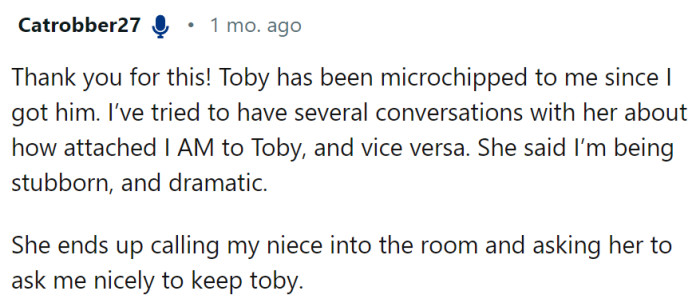
"It’s up to her parents to manage this in a healthy manner."
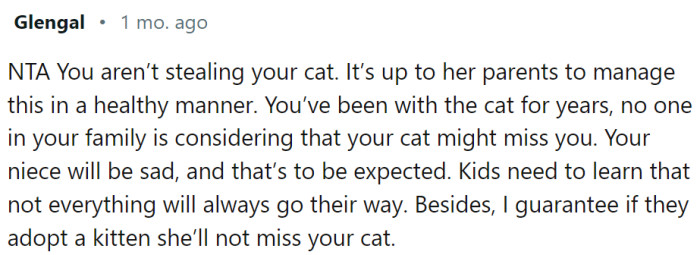
This is definitely a bad approach:
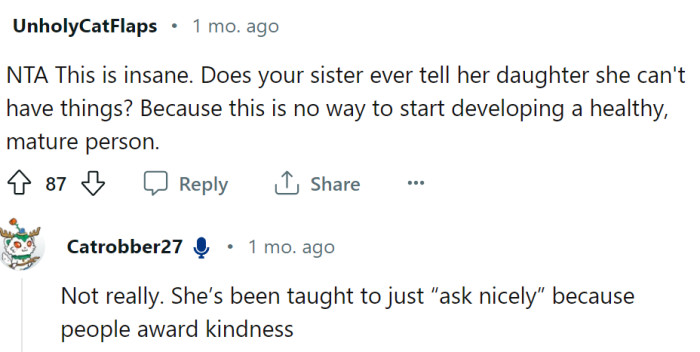
Pets often symbolize stability and comfort during life transitions. The emotional toll of relocating can leave individuals feeling vulnerable and anxious.
A study published in the journal Psychological Science highlights how pets can help alleviate feelings of loneliness and provide a sense of continuity. In OP's case, Toby represents not just a pet but also a source of comfort amid her transitional phase. Recognizing this may help OP understand her fierce protection of Toby during family dynamics.
Coping with Conflict
Conflicts over pet ownership can trigger feelings of jealousy and possessiveness, which may require emotional regulation strategies.
Practicing mindfulness and stress-reduction techniques can help individuals manage these intense emotions and promote healthier interactions.
No means no, and it is about time this girl learns the lesson
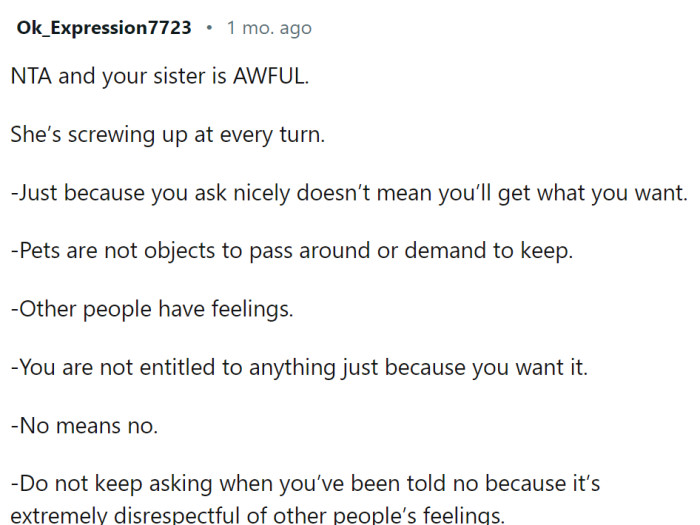
This is a good suggestion

The bottom line is:

The Importance of Boundaries
Setting boundaries is essential in maintaining healthy relationships, particularly when emotions are involved. According to clinical psychologists, clear communication fosters mutual respect.
Research indicates that establishing boundaries can lead to healthier interactions and reduce feelings of resentment. OP might consider discussing her need for Toby’s return with her sister, framing the conversation around their family dynamics and emotional well-being. This approach can help avoid misunderstandings and promote a collaborative solution that respects everyone’s feelings.
OP posted an update
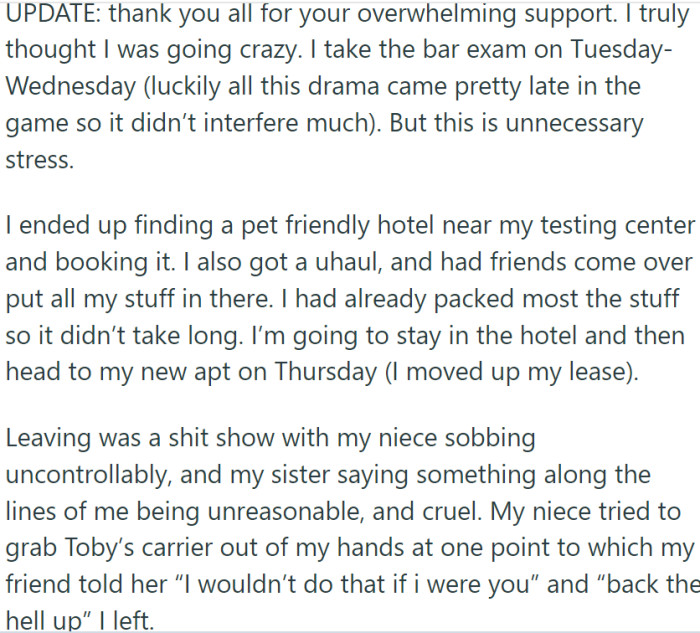
Her sister is delusional

This was definitely an unhealthy environment, and OP and her cat are safe now
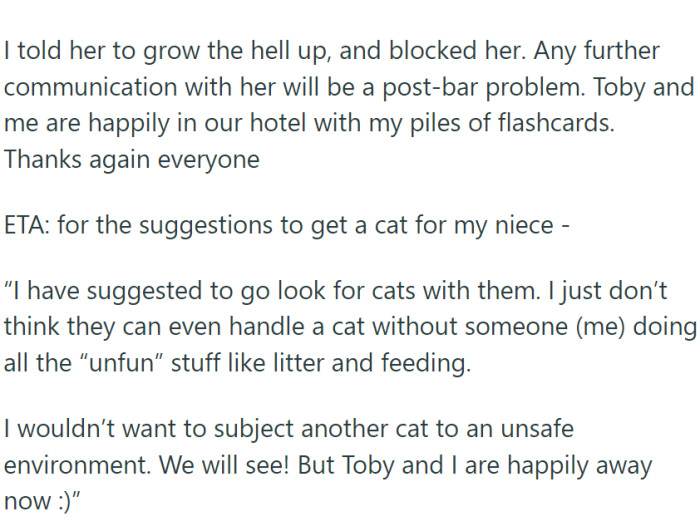
The psychology of ownership is complex and often intertwined with identity and emotional attachment. Research shows that individuals perceive their pets as extensions of themselves, which can intensify feelings of possessiveness.
According to Dr. Alan Beck, a renowned animal behavior expert, recognizing this attachment is crucial for both OP and her niece. Each must navigate their feelings while understanding that Toby is a shared familial entity during this transitional living arrangement. Balancing emotional needs will be key to resolving the situation.
OP's sister's reaction to claim Toby as their own, without any prior discussion, was way out of line. Toby has been with OP for seven years, and that's not something you can just dismiss.
OP's offer to help the family adopt a new cat was a reasonable compromise, but the family's refusal and insistence on keeping Toby feels unfair. It's heartbreaking to see a child upset, but let's be real: Toby is OP's cat, and she has every right to take him with her.
The way OP's family has handled this situation has been frustrating to watch. The fact that they've tried to guilt-trip OP by bringing other family members into the situation only makes it worse.
Instead of supporting their daughter and sister, they've turned this into an unnecessary battle.
Psychological Analysis
This situation illustrates the complexities of attachment and ownership in relationships involving pets. The niece's claim suggests a strong emotional connection that may not be fully understood by the woman.
Open dialogue about feelings and responsibilities can help bridge this gap and promote understanding.
Analysis generated by AI
Analysis & Alternative Approaches
Understanding the psychological dynamics of pet ownership and attachment can aid in resolving conflicts.
Research suggests that fostering open communication and empathy can create a supportive environment for all parties involved.
Ultimately, prioritizing emotional awareness can lead to more harmonious relationships.
Psychological Analysis
This situation shows the strength of emotional attachments, especially in children, and how these bonds can blur the line of ownership. The niece's quick attachment to the cat and perceived ownership reflects her strong emotions and lack of understanding about boundaries. It's important to remember that while her feelings are valid, it's also crucial to respect existing relationships and ownership, a lesson that seems to have been overlooked in this case.
Analysis generated by AI
In navigating the complex dynamics of pet ownership, particularly during transitional periods, it's crucial to prioritize communication and empathy. Understanding attachment theory and the emotional significance of pets can foster healthier interactions among family members.
By setting clear boundaries and engaging in open dialogue, OP can address her needs while also considering her niece's feelings. Utilizing emotional regulation strategies will pave the way for a more harmonious resolution, ensuring that every family member feels valued and understood.
